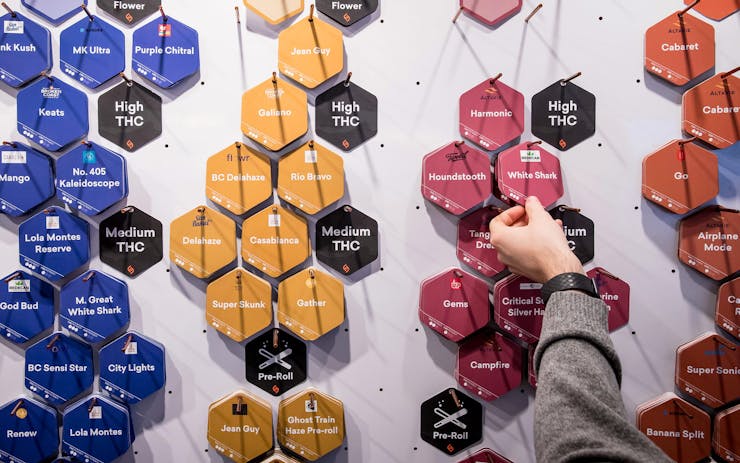Cannabis strain names are chosen for a variety of reasons including how a plant and its flowers look, its taste and smell, its history or origin, or because a corporation named it such.
While the thought of a group of smart people locked inside of boardroom, sitting around an open thesaurus while shouting word combinations at one another until something sticks provides a great visual, the way the Canadian cannabis industry names its products (or, in some cases, doesn’t) is often much more simple. And more quiet.
Some cultivators have developed their own strains and have carte blanche when it comes to naming their proprietary plants. Others are renaming existing strains, layering nomenclature on nomenclature, which, as you can imagine, often leaves both budtenders and consumers scratching their heads.
And then there are the folks who are letting the strain’s existing reputation do the work by leaving the labels it came with untouched.
“It’s gotten silly out there,” says Mathew Stockton, head of marketing and brand at Qwest, a luxury cannabis brand cultivated by We Grow in Creston, BC. “Some companies have the exact same strain in their portfolios under different brands, with different names. That just causes confusion and I’ve seen budtenders first-hand call bullshit on it.”
We spoke with several Canadian LPs to better understand how and why they chose their strain names.
When you have a proprietary strain, you can do what you want
At Tantalus Labs, there are currently two proprietary strains: Serratus and Sky Pilot.
The latter is a cross between Blue Dream and Snow Lotus; it’s a sweet and pungent strain named for the snow-covered Sky Pilot peak in Squamish, BC, which is in the Tantalus Mountain Range.
“This high-THC strain features large buds with an ultra-frosted appearance,” says Dan Sutton, CEO of Tantalus Labs. “The scent of blueberry with hints of spice and pine makes for a familiar diversion from the classic Blue Dream strain.”
Fitting, right?
While Tantalus is proud to tout its BC roots, the company is also keen to honour cannabis history.
“When our products reflect a curated version of a well-known strain, we use the strain name that customers will expect. When our breeding and selection process results in unique characteristics, we choose to create a new name. In both instances, the flower is the foundation for the name, and must reflect the unique botanical characteristics of the plant,” says Sutton.
Shop highly rated dispensaries near you
Showing you dispensaries nearRenaming strains is done strategically and only when it makes sense
There are four adult-use brands in Aphria’s portfolio—Solei, Riff, Good Supply, and Broken Coast—and each one has its own naming system.
Good Supply, a value-for-money brand, has purposely left its strains names the way they were when they arrived. “We maintained the original strain names on this brand because that’s what those users are accustomed to,” says Megan McCrae, chief marketing officer at Aphria.
Solei, on the other hand, uses a “moments-based approach,” so customers can decide how they want to feel and choose a strain accordingly.
“The strains are consistently named Renew, Unplug, Balance, Free, Gather, and Sense, each reflecting the type of moment our consumers want,” says McCrae. “Renew is a high-THC indica, perfect for a good night’s sleep. On the contrary, Gather is a higher-THC sativa, perfect for an uplifting experience or social gathering.”
Keeping original names adds clout
Qwest quickly learned that the old adage “if it ain’t broke, don’t fix it” rings true in the cannabis world.
“When we first launched, we renamed strains and instantly regretted it,” says Stockton. “So we changed them back.”
He uses Super Lemon Haze as an example.
“It has a wonderfully zesty lemon aroma and with the limited ability to communicate (due to regulations), we thought it would be smart to put the Qwest name in the name of the strain, so it became ‘Zest Qwest’. It highlights one of the key attributes (zesty), and gets the brand name in there.”
Zest Qwest isn’t necessarily a bad name, as Stockton points out, but the budtenders selling it just couldn’t get behind it.
“They were right,” says Stockton. “They knew our authentic approach to craft cannabis and called us out on the naming convention. We listened.”
The folks at Qwest have also worked with Capulator (the world-famous cannabis breeder) to bring the MAC 1 strain to Canada. They aren’t renaming this strain either.
“MAC 1 is a legend and we wouldn’t change that name,” says Stockton. “It has its own cachet and in a way, it’s a brand in itself.”
Sometimes government guidelines get in the way
Another thing to consider is that original strain names don’t always work within Canadian regulations and guidelines.
“Ice Cream Cake, for example, goes against the rules of ‘appealing to children’ so we simply shortened it to Ice C.C.,” says Stockton.
Original or ‘street’ names also perform better on the market
United Greeneries, the cultivators of Harvest One, purposefully use original strain names so that there’s less confusion between the public and the producers.
“Our provincial regulators have indicated that street names are inherently better performers in the marketplace,” says Stephen Parker, director of cannabis marketing and retail sales at United Greeneries/United One. “There is so much for consumers to adjust to in the new legal market that we do not need to be confusing them with strain names that they are completely unfamiliar with.”
Watch Leafly TV
Click here to discover more videos on Leafly TV.





